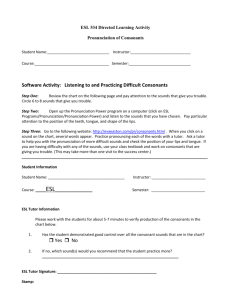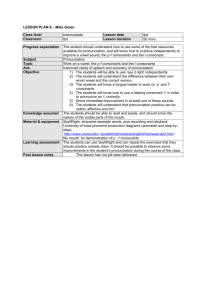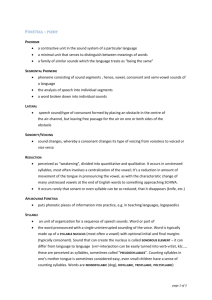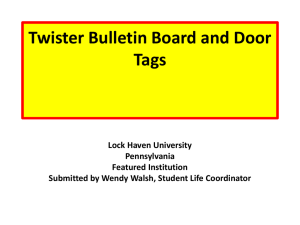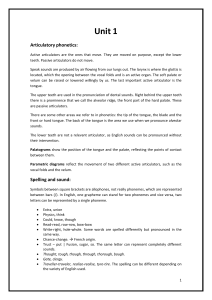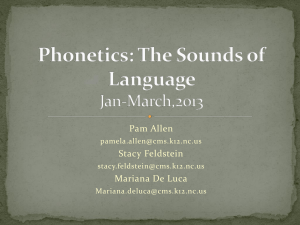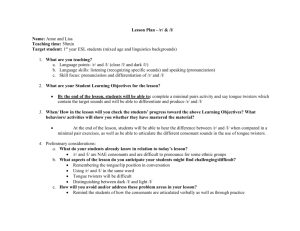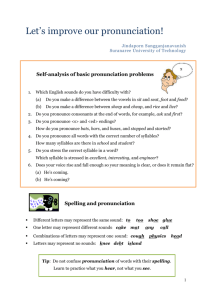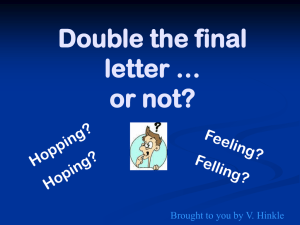EFL Lesson Plan: /θ̠/ and /ð̠/ Pronunciation for Mandarin Speakers
advertisement
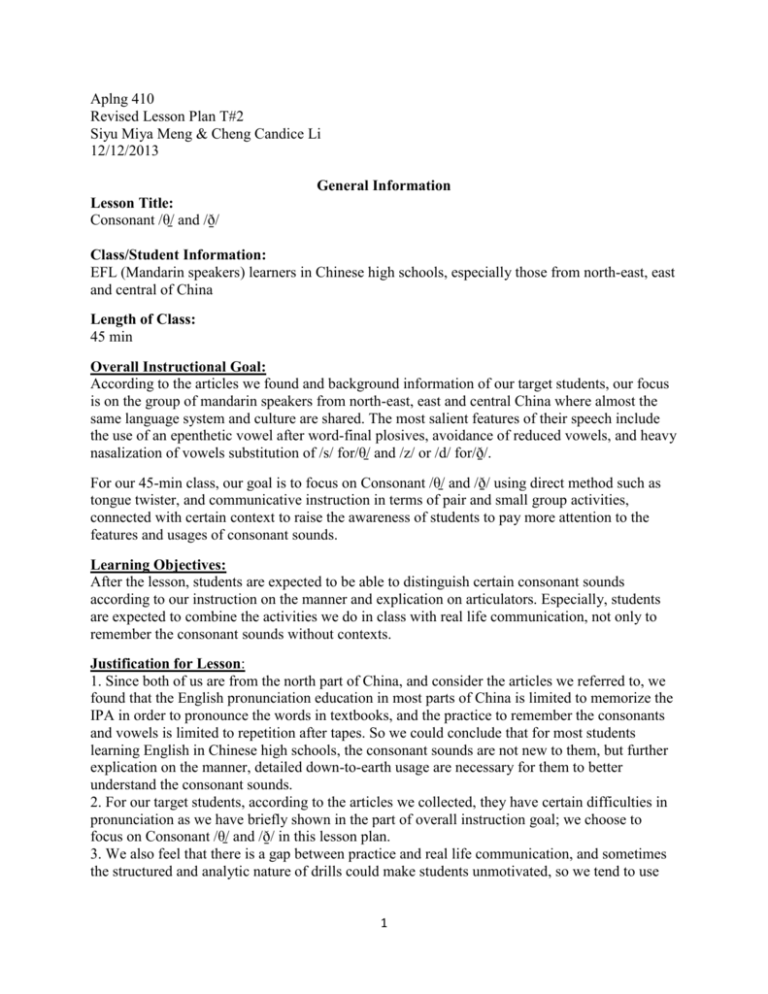
Aplng 410 Revised Lesson Plan T#2 Siyu Miya Meng & Cheng Candice Li 12/12/2013 General Information Lesson Title: Consonant /θ̠/ and /ð̠/ Class/Student Information: EFL (Mandarin speakers) learners in Chinese high schools, especially those from north-east, east and central of China Length of Class: 45 min Overall Instructional Goal: According to the articles we found and background information of our target students, our focus is on the group of mandarin speakers from north-east, east and central China where almost the same language system and culture are shared. The most salient features of their speech include the use of an epenthetic vowel after word-final plosives, avoidance of reduced vowels, and heavy nasalization of vowels substitution of /s/ for/θ̠/ and /z/ or /d/ for/ð̠/. For our 45-min class, our goal is to focus on Consonant /θ̠/ and /ð̠/ using direct method such as tongue twister, and communicative instruction in terms of pair and small group activities, connected with certain context to raise the awareness of students to pay more attention to the features and usages of consonant sounds. Learning Objectives: After the lesson, students are expected to be able to distinguish certain consonant sounds according to our instruction on the manner and explication on articulators. Especially, students are expected to combine the activities we do in class with real life communication, not only to remember the consonant sounds without contexts. Justification for Lesson: 1. Since both of us are from the north part of China, and consider the articles we referred to, we found that the English pronunciation education in most parts of China is limited to memorize the IPA in order to pronounce the words in textbooks, and the practice to remember the consonants and vowels is limited to repetition after tapes. So we could conclude that for most students learning English in Chinese high schools, the consonant sounds are not new to them, but further explication on the manner, detailed down-to-earth usage are necessary for them to better understand the consonant sounds. 2. For our target students, according to the articles we collected, they have certain difficulties in pronunciation as we have briefly shown in the part of overall instruction goal; we choose to focus on Consonant /θ̠/ and /ð̠/ in this lesson plan. 3. We also feel that there is a gap between practice and real life communication, and sometimes the structured and analytic nature of drills could make students unmotivated, so we tend to use 1 communicative instruction which combine instruction with real life communication to conduct our activities. Materials: Computers, Internet, blackboard, cards, and handouts. Use the Communicative Framework for progression of teaching skills: 1) Description & Analysis 2) Listening Discrimination 3) Controlled Practice 4) Guided Practice 5) Communicative Practice The Lesson Plan WHY & HOW (describe the activities) (justifications for activities & grouping of students) Orientation (5 min.) Try the tongue twister below: /ð̠/ /θ̠/ /θ̠/ /θ̠/ /ð̠/ /ð̠/ /θ̠/ /ð̠/ /θ̠/ /ð̠/ Those three thugs think that they threw those things there Definition of tongue twister: Tongue Twisters are groups of words which begin with the same sound and are hard to pronounce--especially when you say them quickly! Tongue twister is a technique from L1 correction, and our target students are also familiar with certain features of tongue twister. Also, according to their background, I believe they could detect some of the /θ̠/and/ð̠/ in the tongue twister. Purpose: Orient to the focus for today, /θ̠/ and /ð̠/; Let students try to remember the tongue twister as an awareness of consonant /θ̠/and/ð̠/ if they are interested. Transition/Justification: We think tongue twister is an easy and fun way for students to practice, and as an orientation, it can raise students’ awareness of our targeted sounds. Presentation (5 min.) 1. point out that /θ̠/ and /ð̠/ are fricatives; 2. briefly introduce that fricatives should be produced without stopping the airstream; and the tongue should be placed between teeth and practice by protruding tongue between teeth to feel the feelings when articulate the two consonants. A video will be shown from ‘Rachel’s English’ to let students directly see what the articulators are like during speaking http://www.rachelsenglish.com/videos/learn-ipaconsonants 2 Directly show students how to articulate the consonants /θ̠/ and /ð̠/appropriately, to give students a deep impression on how these articulators are placed and how they feel when pronounce them. Transition/Justification: It is important for students to get systematical knowledge of these two sounds, and how to pronounce them in a right way. Presenting students these two pronunciations by using articulator positions can make their learning of pronunciation solid. Engagement (20 min.) Since most of the ordinal numbers contain Act 1:Use ‘Body parts’ to focus on /θ̠/ : mouth, the /θ̠/ sound: ’third’, ‘fourth’, ‘fifth’, etc. tooth/teeth, throat, thumb, and thigh; and the body parts as examples which also Role-play between a doctor/dentist and a patient: contain /θ̠/. Combing these two is to provide The students playing the patient receives a card with a students a certain context to further practice drawing of the body part that hurts, and the other students the /θ̠/ and /s/. Since our target students are receives a card with commands that cue the questions that EFL students who are not available in doctor should ask the patient(eg: Find out what is wrong?) immersion situation. So we hope these vivid A few sessions later, use a calendar for the current month words as reminders to realize the usage of as a context for practice /θ̠/ in numbers with 3, ordinals, certain consonants. and in the words Thursday and month. For pair work, the students in roles of doctor/dentist and Students are divided into small groups and patient would try to make an available appointment for pairs. So we could observe the class when their next meeting. they are finishing the activities and act as a resource when students have questions that they cannot resolve by themselves. Act 2: Guided-practice Activity: Family Tree /ð̠/ Kinship terms are used since many of them have the sound of /ð̠/: mother, father, brother, grandmother, grandfather, brother in law. Students work in pairs asking about the relationship of the people in a family tree. (as shown in PPT) Once students have moved through the guided practice phase, they can do a related communication activity, like the following: On a sheet of paper, complete your family tree, going back as far as your grandparents. Then tell your partner about your family. Transition/Justification: Since students’ participation should be engineered in this part, we think role play and a topic from a famous Chinese TV show can draw students’ attention, and provide them an opportunity to use English as a tool to express something they are interested in. 3 Evaluation (10 min.) Act 3: Guided Activity: scrambled mini-dialogues (/θ̠/ and /ð̠/) • 1. Let’s ask Thelma to join in us on Thursday for your birthday. • 2. Thad and I are through! I’ve thoroughly lost my faith in our relationship. • 3. Is your new boyfriend wealthy? • 4. I think Beth is too thin, don’t you? • 5. The hotel room is filthy! Everything is covered with dust. • 6. They say the weather forecast is for continued temperatures in the high 30s! • 7. This bath gel is very soothing. • • • • • • • In this activity, the teacher should pair students, giving Partner A the first half of the scrambled dialogues and the Partner B the second half (handouts). Partner A begins the activity by reading minidialogue1. Partner B selects an appropriate response (in this case, choice E), and so on. After students have figured out the answers and practiced on their own, various pairs can be called on to perform the minidialogues for the rest of the class. A. This heat spell will be the death of me! I can barely breathe! B. I agree. It’s a health hazard. Let’s both go throw a fit and demand another room. C. Yes, I always use it when I bathe. It has such a nice lather. D. Have you thought about couples therapy? Maybe you can both work through your differences with a good therapist. E. Let’s ask Ruth instead. I loathe Thelma! F. Yes, he has a house worth about three hundred thousand dollars! G. She’s a lot thinner than she was before. But she looks healthy to me! Summary Statement(s): After all students have completed the instructional activities, the evaluation part works as a reconvention to recap the main points of the lesson, and in this part, through the guided activity, teachers can check students’ understanding of the knowledge, and see if they have any other problems related. Our expansion part as an assessment could encourage students to review this knowledge after school, and they will have chance to check it they understand the pronunciation they learned. Expansion (5 min.) Communicative Practice: Storytelling (/θ̠/ and /ð̠/) Thelma, Thad, Thursday, thief, breathe, thigh, month, together, teeth, bathe, mother, worthy, thank, thick, thought, cloth, mythic, thread, thwart, width… 4 Students are provided with a context and key words that contain the targeted sounds. Have students create a story using these words in any order. (Either write them down or produce the story orally) Or other words you can think about in which there is pronunciation of /θ̠/ or /ð̠/ Next class students will be asked to work in pairs, as each student tells his or her story, the partner listens and checks off which words on the list are used. He or she also checks whether these words are pronounced correctly and whether they make sense within the context of the story. As a follow-up activity, the partner can try to retell the story, using the words they checked as a guide. In this way, students will have time to absorb what they have learned in class and practice after class. For the words they are not familiar with, they can look them up in dictionaries. And because next class they need to tell their stories to other classmates, it would help them pay more attention to their pronunciation. Special notes: As some of our classmates suggested, we can organize our activities basing on themes. Because various themes will make a lesson look not so coherent, maybe only one theme for a lesson would be better. So the activities in this lesson plan can be expanded and revised, and used separately in a series of lessons basing on themes. 5
